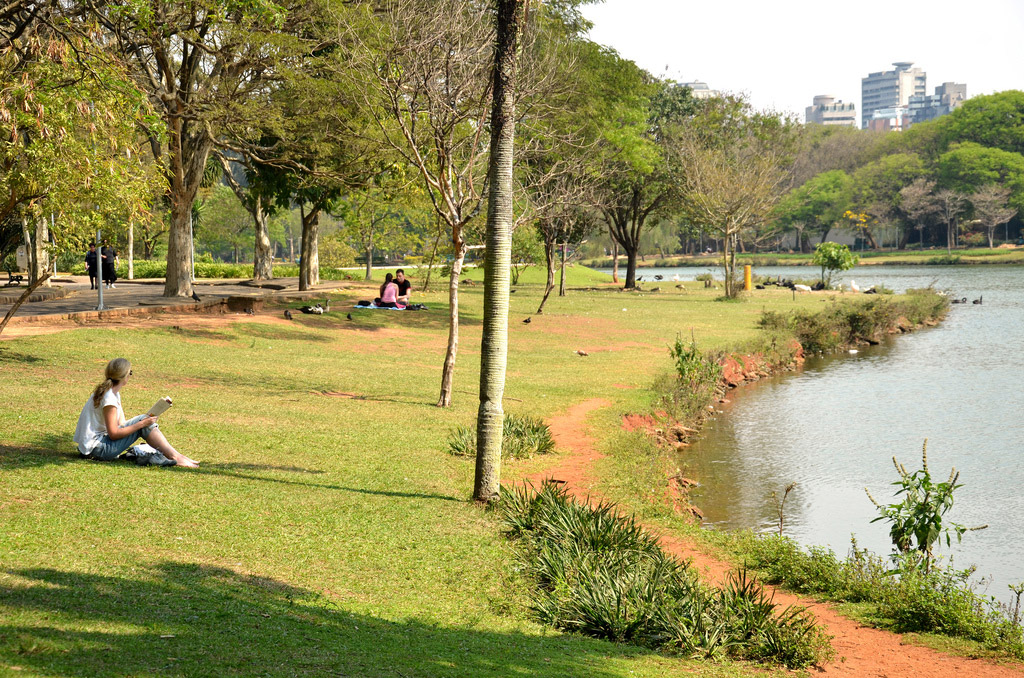
This sweeping 160-hectare (395-acre) expanse of green is popular with tanners, readers, and picnickers. Photo © Rodrigo Soldon, licensed Creative Commons Attribution No-Derivatives.
Paulistanos’ equivalent of Central Park is Parque do Ibirapuera (entrances on Av. Pedro Alvares Cabral, Av. República do Libano, and Av. IV Centenario, tel. 11/5573-4180, 5 a.m.–midnight daily, free), a sweeping 160-hectare (395-acre) expanse of green that Paulistanos unironically refer to as their “praia” (beach). Indeed, on any given sunny summer weekend its tree-shaded lawns are so blanketed by sprawlers, tanners, readers, and picnickers that the comparison is not far-fetched. Contrasting with the futuristic buildings, Burle Marx’s inspired landscaping mingles sweeping lawns with ponds, wooded areas, and bursts of flowers and tropical foliage.Created in the 1950s to commemorate Sampa’s 400th anniversary, the park project was headed by two stellar talents of the day: Oscar Niemeyer and Roberto Burle Marx. Various curvy, concrete, well-illuminated Niemeyer pavilions today house a handful of top-notch museums, earning the area the nickname of “Museulândia.” Contrasting with the futuristic buildings, Burle Marx’s inspired landscaping mingles sweeping lawns with ponds, wooded areas, and bursts of flowers and tropical foliage. There is also a planetarium, a sculpture garden, and a Japanese pavilion modeled after the Katsura Imperial Palace in Kyoto. Music lovers can rock out at the free open-air concerts often held at a Roman-style amphitheater or enjoy more erudite melodies at the Niemeyer-designed Auditório Ibirapuera. The athletically inclined can rent bikes, or go jogging, skateboarding, or rollerblading along scenic trails, but be aware that they can become congested with toned and trim locals.The easiest way to get to the park is to take the Metrô to Brigadeiro station. Then take one of many buses or walk (around 30 minutes) down Avenida Brigadeiro Luís Antônio until you reach Portão 9, one of numerous entrances to the park. Dominating the Praça General Estilac Leal is the dramatic Monumento às Bandeiras. The work of renowned modernist sculptor Victor Brecheret, this imposing granite landmark pays homage to the intrepid 16thand 17th-century adventurers of Portuguese origin (the bandeirantes) who opened up much of Brazil’s interior.
Designed by Oscar Niemeyer, the Pavilhão da Bienal de Arte is a vast rectangular building with glass windows and sky-high ceilings. It opened in 1957 to house the São Paulo Bienal de Arte, one of the world’s largest and most important art biennials. Held in even-numbered years during October–November, this event reunites more than 12,000 works by national and international artists. There are usually plenty of misses along with the hits, but since it is free (and arguing about the quality of the art in a bar afterward is a spirited Paulistano ritual) you can wander around to your heart’s content, focusing on the provocative stuff and ignoring the drivel. Many other events take place at the Pavilhão, among them the Bienal de Arquitetura (held in even-numbered years) and Brazil’s twice-yearly biggest fashion event, São Paulo Fashion Week.
On the third floor is a small branch of the Museu de Arte Contemporânea (MAC) (Pavilhão da Bienal, 3rd Floor, tel. 11/5573-9932, 10 a.m.–7 p.m. Tues.–Sun., free). Although its permanent collection is modest, interesting temporary exhibitions of contemporary art are held here. To view the much more impressive main collection—considered one of Brazil’s finest collections of contemporary art—you’ll have to visit the MAC at the University of São Paulo (USP, Rua da Reitoria 160, Cidade Universitaria, tel. 11/3091-3039, 10 a.m.–6 p.m. Tues.–Fri., 10 a.m.–4 p.m. Sat.–Sun., free). Plans are in the works to reunite the entire MAC collection within the park’s Detran building, hopefully by the end of 2011.
The first modern art museum to be founded in Latin America, the Museu de Arte Moderna (Portão 3, tel. 11/5549-9688, 10 a.m.–6 p.m. Tues.–Sun., R$5.50, free Sun.) actually focuses more on Brazilian contemporary works than modern art per se (this due to the confusing fact that in 1963, the MAM’s director donated the modern collection to MAC—as a result, when the museum began rebuilding its collection, its focus was on contemporary pieces). A trio of temporary exhibits showcases works from the permanent collection along with visiting national and international exhibitions. The curving glass and concrete building was designed by Oscar Niemeyer and then renovated by Lina Bo Bardi in the 1970s. Aside from a museum shop, there is a lovely minimalist restaurant, serving contemporary fare, that looks out onto the sculpture garden and the Oca, a spacey dome-shaped Niemeyer pavilion—the name “Oca” comes from its resemblance to similarly shaped indigenous dwellings—where temporary art exhibits and other events are held.
Niemeyer also designed the pavilion that houses the Museu Afro Brasil (Pavilhão Padre Manoel da Nóbrega, Portão 10, tel. 11/3320-8900, 10 a.m.–5 p.m. Wed.–Mon., free). This is a museum you shouldn’t miss: Its three floors offer a compelling look at the rich historical, cultural, and artistic legacies of Brazil’s Afro-descendent population, dating from the 16th century to the present day. Highlights include finely crafted African artifacts along with objects and clothing used in Afro-Brazilian celebrations and rituals. Particularly harrowing is a room devoted to the slave ships that brought so many Africans—literally packed side-by-side like sardines—to the New World. Insightful temporary exhibits by black artists from Brazil and overseas offer more contemporary visions of the African diaspora.
Yet another Niemeyer pavilion shelters the Pavilhão das Culturas Brasileiras (Portão 10, tel. 11/5083-0199, 9 a.m.–6 p.m. Tues.–Sun., free). Devoted to Brazil’s undeniably rich forms of arte popular, this dynamic new museum sets up some interesting and unexpected dialogues between indigenous art, regional folk art, and contemporary urban design in both its permanent and temporary exhibits. You’d be surprised at the parallels between a wooden stool carved by Amazonian artisans and a chair dreamed up by the Campana brothers. For a glimpse at Brazilian creativity and ingenuity at its most beguiling, this museum is highly recommended.
Excerpted from the Third Edition of Moon Brazil.